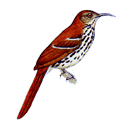 The Cozumel ThrasherHome
Natural history
Created by Robert L. Curry
|
Natural history of the Cozumel Thrasher |
||||
OriginEvolutionary relationshipsBehavior
Descriptions of habits before the species became as rare as it is todayEven some of the earliest naturalists to visit Cozumel described the Cozumel Thrasher as being difficult to observe. For example, Griscom (1926) wrote: "The occurrence of a Thrasher on Cozumel Island is perhaps its most interesting zoögeographical feature. It is a very common bird, but rather shy and secretive, living in the heart of the densest thickets. Here in the dim light, with the ground carpeted with dead leaves, it melts into the background. Your approach is inevitably somewhat noisy, and if hunted in this way, a dark shadow has suddenly ceased to exist about the time you realize you have seen a Cozumel Thrasher running away over the ground. Ensconced in the heart of a thicket, however, squeaking produced excellent results, thanks to the extraordinary bump of curiosity possessed by nearly all the endemic birds of the island. In a few seconds I would be surrounded by Melanoptila, and peering sharply about would finally make out the head and pale yellow eye of a Thrasher or catch a nervous lift of the tail. But I never saw one arrive. It always appeared. The song is sweeter and richer in tone than that of our own Brown Thrasher, but softer and lower. The bird sings concealed in the thickets and the distance of the singer is somewhat difficult to judge. It is a much more frequent and rapid runner than the Brown Thrasher." Paynter (1955, based on field observations in January 1949) agreed: "Fairly abundant species on the island, but excessively shy and difficult to collect." But not all observers noted the bird's secrecy. This was the account of Bond (1961, based on observations in February 1961): "I regularly encountered this thrasher in woods near the airport. It was not in song: its harsh alarm note resembled that of T. rufum." Ecology |
||||